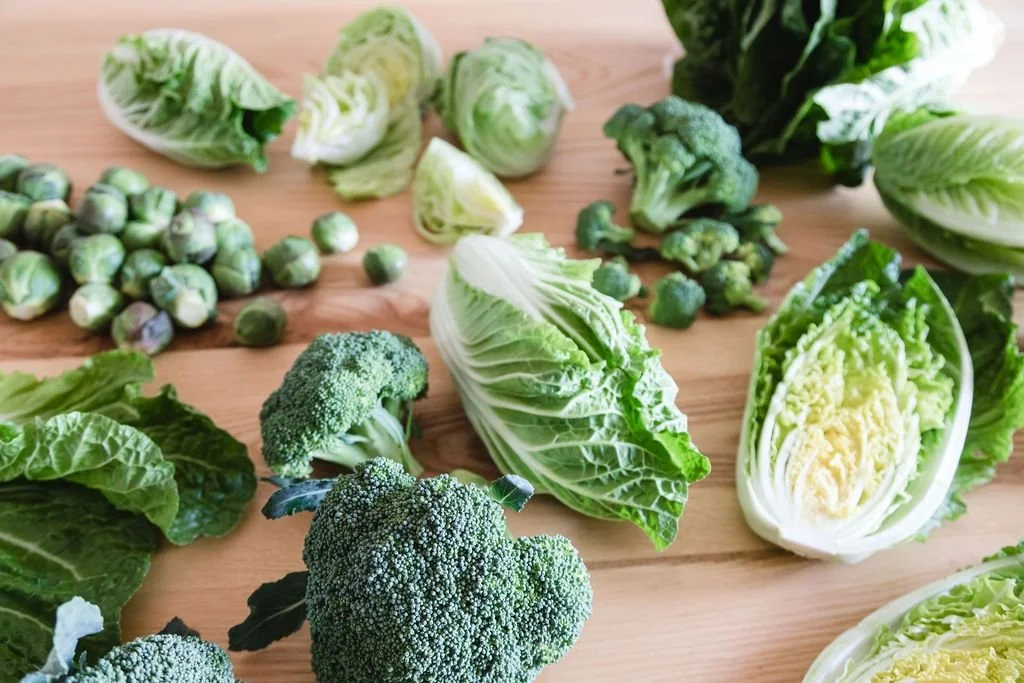Most people know that vegetables are a rich source of fiber, vitamins, and minerals, but did you also know that some veggies earn high marks for their impressive protein content?
Adding protein-packed produce to your diet is a smart and sustainable way to simplify your meal prep and enjoy healthy alternatives to beef, chicken, and seafood.
Let’s take a look at which vegetables are high in protein, full of flavor, and easy to cook.
Leafy Green Staples
1. Spinach
What It Is: Spinach is one of the most popular and versatile green leafy vegetables. It can be enjoyed raw, steamed, or sauteed and makes the perfect base for hearty salads.
Protein: 5g protein per cup (cooked)
How to Select: Quality spinach is dark green with no yellow or wilted leaves. Because fresh spinach is usually sold in bags, inspect the bottom of the bag for any slimy or brown leaves.
Recipe Ideas: If pasta is your comfort food, try this creamy tomato and spinach pasta recipe to get your greens in alongside your favorite food.
2. Kale
What It Is: Leafy kale is a nutrient-rich cruciferous vegetable that serves up generous amounts of fiber, calcium, iron, and antioxidants.
Protein: 5g protein per cup (cooked)
How to Select: Look for firm, deep green leaves, and avoid bunches that look yellow or wilted.
Recipe Ideas: This delicious and nutritious chopped salad has a base of kale and napa cabbage with a garlic dill dressing.
3. Collard Greens
What It Is: Known for their sturdy texture and slightly bitter taste, collard greens are a staple of Southern cooking.
Protein: 4g protein per cup (cooked)
How to Select: Choose bunches of dark green leaves with no yellow or brown spots.
Recipe Ideas: This Southern collard greens recipe combines the leafy vegetable with bacon, garlic, onions, and a rich mix of seasonings.
4. Bok Choy
What It Is: Also known as Chinese cabbage, bok choy is a tender, sweet, and mild green featured in many Asian dishes.
Protein: 3g protein per cup (cooked)
How to Select: Select bunches with bright green leaves and firm white or green stems.
Recipe Ideas: Make an easy bok choy stir fry by adding the leafy green to a wok with chopped garlic and ginger.
Versatile Cruciferous Veggies
5. Broccoli
What It Is: Fiber-rich broccoli is one of the most popular vegetables, with high levels of protein, vitamin C, potassium, folate, and beta carotene.
Protein: 2.6g per cup (cooked)
How to Select: Choose heads of broccoli with tightly packed florets and firm stalks.
Recipe Ideas: This comforting broccoli soup, made with chicken stock, garlic, and onions, is a great way to get in your daily greens.
6. Brussels Sprouts
What It Is: These small, cabbage-like vegetables are a low-calorie source of fiber and healthy nutrients.
Protein: 3g protein per cup (cooked)
How to Select: Look for sprouts with tightly wrapped leaves that feel firm to the touch.
Recipe Ideas: These purple Brussels sprout tacos are a fun and flavorful way to pack more veggies into your diet.
7. Cauliflower
What It Is: Cauliflower is a white cruciferous vegetable that's often used as a low-carb substitute for mashed potatoes, rice, and other starches.
Protein: 2g protein per cup (cooked)
How to Select: Choose cauliflower with tightly packed heads and bright, firm green leaves.
Recipe Ideas: If you enjoy Mediterranean food, try this broccoli and cauliflower chermoula made with golden raisins and olives.
Protein-Packed Legumes
8. Edamame
What It Is: Edamame are young soybeans, usually found in pods, that are absolutely packed with protein.
Protein: 17g protein per cup (cooked)
How to Select: Fresh and ripe edamame is firm, bright green, and slightly fuzzy. You may not be able to find fresh edamame at your regular supermarket, but most stores offer frozen edamame.
Recipe Ideas: This dry roasted edamame with garlic and Parmesan cheese is crunchy and savory, making it a great healthy alternative to chips.
9. Lentils
What It Is: Lentils are small legumes, usually sold dried, that come in brown, green, and red varieties. They're inexpensive, easy to cook, and full of nutrients.
Protein: 18g protein per cup (cooked)
How to Select: Dry lentils are sold in bags and can be stored in your pantry indefinitely. Look for a bag of lentils that are uniform in color with little or no debris.
Recipe Ideas: Lentil soup is one of the healthiest, tastiest, and most protein-packed plant-based meals you can ever make.
10. Fava Beans
What It Is: Also known as broad beans, fava beans are flat, pale green beans that can be eaten raw, cooked, or dried.
Protein: 10g protein per cup (raw)
How to Select: Select firm and thick pods that are fully closed. If the beans are bulging out from the pods, they may be past their peak freshness.
Recipe Ideas: This fava bean dip makes a yummy and healthy snack when paired with crackers, tortilla chips, or chopped vegetables.
11. English Peas
What It Is: English peas are a popular variety of garden pea that are sold fresh, canned, and frozen.
Protein: 8g protein per cup (cooked)
How to Select: Look for firm and smooth pods that are evenly colored. Smaller pods are usually sweeter and more flavorful than large or bulging pods.
Recipe Ideas: This spring vegetable rigatoni is fresh, flavorful, and high in protein and fiber.
12. Sweet Corn
What It Is: Sweet white corn is a delicious and versatile summer staple that's perfect for salads, salsas, chowders, and more. It has a higher sugar content and lower starch content than most other varieties of corn, so it's a great way to add some natural sweetness to your diet.
Protein: 5g protein per cup (cooked)
How to Select: Choose ears of corn with bright green husks that feel heavy and firm in your hand.
Recipe Ideas: This corn and chicken chowder is hearty, filling, and full of protein.
Other Nutritious Favorites
13. Artichokes
What It Is: The artichoke is a type of thistle, but it's also a healthy, edible plant that delivers protein, magnesium, phosphorous, and calcium.
Protein: 4g protein per artichoke
How to Select: Artichokes that feel heavy are usually juicy and fresh. You should also look for artichokes with green, compact leaves.
Recipe Ideas: Dip steamed artichokes into this flavorful sauce, made with mayo, lemon juice, and dijon mustard.
14. Asparagus
What It Is: Asparagus is a springtime favorite that's great for your cognitive functioning and your digestive system.
Protein: 4g protein per cup (cooked)
How to Select: Select firm spears with slightly closed tips. If the asparagus feels bendy or limp, it's past its peak freshness.
Recipe Ideas: Roasted asparagus is a delicious side dish, especially in the spring and summer. This recipe uses fresh parsley and a drizzle of lemon to balance out the earthy flavor of the asparagus.
15. Avocado
What It Is: While technically a fruit, we included avocados on our list because they're such a popular choice for those looking for a high-protein snack. Avocados are also rich in monounsaturated fat, which reduces your LDL cholesterol levels.
Protein: 4g protein per avocado
How to Select: Look for dark green avocados that feel slightly soft but not mushy when you squeeze them.
Recipe Ideas: This recipe combines buttery avocados, napa cabbage hearts, and citrus into a colorful and healthy salad topped with a miso vinaigrette.
Plant Based & Protein-Packed
You don't have to drink shakes and eat plain grilled chicken all day to meet your protein goals.
If you're trying to get more protein in your diet, try incorporating some of these vegetables in your meals.
Not only do these veggies offer a protein boost, but they'll also help you reach your fiber, vitamin, and other micronutrient goals.
We hope this list of protein-packed veggies helps you on your journey to better health!
FAQ
Are protein levels affected by cooking vegetables?
Some veggies may lose a little bit of their protein when cooked.
However, some research shows that we absorb nutrients from cooked vegetables more easily than we do from raw produce.
Do high-protein vegetables have a lot of calories?
Vegetables that offer lots of protein, fiber, healthy fats, and other nutrients usually have more calories than veggies that have less nutritional value.
Virtually all vegetables are low in calories, though, so adding veggies to your meals probably won't make or break your diet.
What's the best way to store vegetables?
Most vegetables should be stored in airtight containers in the refrigerator.
Some, like asparagus, can be stored in water to extend their lifespan.
How do I know if my vegetables are fresh?
All veggies are different, but some of the most common features of fresh and ripe vegetables include a bright and even color, firm leaves or stalks, and a pleasant and earthy smell.














